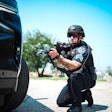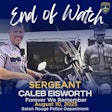 The AG points out, as can be seen in the picture, if the teen had reached the fence, he would have been able to use the knife to attack the officer without having to climb on or over or otherwise interact with the fence. The officer’s position meant the fence would not have protected the officer from a knife attack, the investigation found.Idaho Office of the Attorney General
The AG points out, as can be seen in the picture, if the teen had reached the fence, he would have been able to use the knife to attack the officer without having to climb on or over or otherwise interact with the fence. The officer’s position meant the fence would not have protected the officer from a knife attack, the investigation found.Idaho Office of the Attorney General
The Idaho Office of the Attorney General will not pursue criminal charges against the four Pocatello Police Department officers involved in the shooting death of a nonverbal 17-year-old male who suffered from developmental delays, autism, aggressive behavior, abnormal gait, and other medical conditions.
None of the officers who discharged their weapons were familiar with Perez or his disabilities, according to the investigation.
Victor Perez was shot by officers who had responded to a report of a disturbance involving a man armed with a knife. The attorney general’s investigation learned that the boy's family kept him away from knives, but on April 15, 2025, he got his hands on a large kitchen knife.
A neighbor who was unaware of the teen’s condition called 911 and reported a man who appeared to be intoxicated was wielding a knife and trying to stab other individuals. The caller also said another man hit him in the head with a log, but the man was still trying to stab people.
According to the AG, the struggle between the teen and his family continued for 13 minutes before officers arrived. The investigation also found that “the information available to the responding officers was limited to the information provided by dispatch and did not include any information related to Perez’s disabilities or his age.”
Officers Arrive at the Scene
The four officers arrived in separate vehicles and converged on the backyard at the incident location. Three were armed with duty handguns, and the fourth had a less-lethal beanbag shotgun.
The yard was surrounded by a four-foot-high chain-link fence, and officers observed a male was lying on the ground holding a large kitchen knife. Officers ordered him to drop the knife, but he did not comply.
Read More: Autism Awareness Month: Training Police for Contact
The teen looked at the officers, and then, according to the AG’s office:
“He got up on his knees, lifted the knife in his left hand above his head, and pointed the blade toward the sky. He fell forward and caught himself using his hands. With his hands on the ground in front of him, he put his feet on the ground behind him. He stood up and took a step toward the officers. As he stepped, he put both hands on the knife in front of his body with the blade pointed up and toward the officers. All four officers fired their weapons as Perez continued to move toward them with the knife. Perez’s failure to obey commands to drop the knife and instead to move toward the officers holding the knife appeared to the officers to mean Perez intended to do them harm.”
Proximity to the Fence
All four officers had been standing at the fence, with three clustered together and one further away. The AG investigation found that of the three standing together at the fence, two had stepped back away from the fence. The third one did not. That officer was holding the less-lethal shotgun over the fence.
That officer’s head and upper body were within striking distance from the other side of the fence as Perez advanced, the investigation found.
“The four officers gave estimates ranging from four to ten feet for the distance between the officers and Perez at the time of the shooting. Investigators later estimated the distance to be approximately twelve feet,” the AG findings reported.
In less than two seconds, the officers collectively fired 14 shots and one beanbag round. The autopsy reported Perez was struck by 12 bullets.
Use-of-Force Expert’s Findings
The AG brought in a use-of-force expert to assist in the investigation.
That expert wrote that as Perez “approached the officers while brandishing a large kitchen knife, any reasonable officer would have perceived that action as an immediate threat of death or serious bodily injury.”
Read More: Pennsylvania State Police Distributing Info Card to Autistic People
The attorney general’s office also said that view is supported by legal decisions in which courts have found the use of deadly force justified when someone armed with a knife approaches officers and refuses commands to drop the knife.
“The Office of the Attorney General’s role in this matter is limited to reviewing the investigation for potential criminal charges against the officers. We have concluded only that the State would be unable to prove beyond a reasonable doubt that the use of force was not justified. Our decision means the officers will not face criminal charges under Idaho law,” Jeff Nye, deputy attorney general, chief, criminal law division, wrote.
Read More: Officer With Autistic Son Leads Awareness Efforts





















